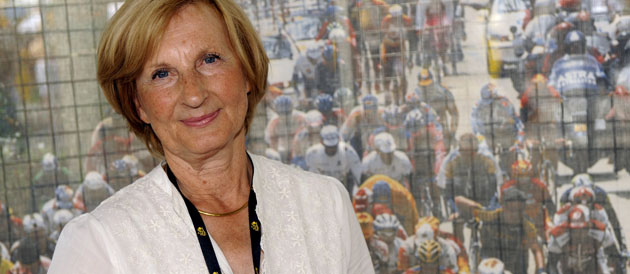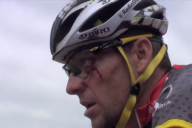In the third part of our ongoing series addressing some of the key issues in the revenue sharing debate we bring the story of the Amaury family up to the current era and consider the Amaury Empire’s matriarach, Marie-Odile Amaury, and the role she played in bringing an end to the ProTour Wars.
For the French media, the seventy-year-old Marie-Odile Amaury is an enigma.
Despite her role at the helm of one of France’s wealthiest family businesses Amaury considers herself a private individual, not a public figure. She’s rarely photographed. Maybe it’s the lack of photographic evidence that causes so many commentators to note her blonde hair, blue eyes and freckled face. She is often presented in the French media as being somewhat reclusive or portrayed as an unlikely millionaire. Heavens to Betsy, commentators love to note she drives a Peugeot 308!
She herself claims to have no social life beyond work. Her pleasure pursuits, she says, are solitary. Books – biographies on the likes of Jean Malaurie, Christopher Columbus, Marie-Antoinette, Stefan Zweig – and music. Rock music. “Hard rock, to me, is a romantic music,” she said in a rare interview last year, “I never tire of the ‘grand ancients‘ like Led Zeppelin, Guns N’ Roses, Metallica, AC/DC. There is an excess of all kinds, in the instrumental, the voice and the characters. Maybe this is a way to stay young!”
The daughter of a Strasbourg optician, Amaury (née Kuhn) comes from solid Catholic stock. A typical Alsatian, she calls herself, with a strong work ethic. A BA in Modern Literature was followed by time at the Strasbourg School of Journalism. But after that it was to the world of marketing, not journalism, that she turned. In Paris she worked at Young and Rubicam and then Havas. The latter was also home to her late husband, Philippe, at the time he was fighting with his sister over their father’s estate. It was also home to Jean-Pierre Courcol: the man who helped Philippe Amaury soften Le Parisien Libéré‘s editorial line; the man who was the shortest serving of the Tour’s directors; the man who helped create ASO in 1992; and the man who took the fall for the Amaury Group’s disastrous investment in the Futuroscope theme park.
Marie-Odile Amaury is a hands-on chief executive. Too hands on, some say, in reference to the influence she wields over the Amaury Group’s newspaper titles. That she influences the editorial line of Amaury Group titles is not a charge she denies. Though the manner of her influence she does question. As far as she is concerned, what she does is all proper and above board: once a year, editorial lines are drawn, she says, and then monitored and adjusted accordingly. Her ‘interference’ is nothing more that that, monitoring and keeping her editors in line.
As for the charge that, in 2008 and with the paper’s circulation in decline, she told L’Équipe to give over banging on about doping, she is reported as saying this: “Doping in sport is a hazard, it must be dealt with when a case breaks, but not as a subject in itself.” So there’s the setting of L’Équipe‘s editorial line for you: report the news, don’t make it.
Now there’s a story or two worth telling here, about previous editorial lines at L’Équipe. David Walsh, interviewed in 2009, spoke of how Pierre Ballester was effectively forced out of L’Équipe because his coverage of doping was interfering with his colleagues’ ability to do their job. The peloton – miffed at Ballester’s continual banging on the doping drum – had decided to boycott not just Ballester but his colleagues at L’Équipe too.
So Ballester’s colleagues complained to their editor. And he complained to Ballester. And Ballester laughed, pointing out how those self-same reporters were doping with the cyclists, enjoying the delights of Pot Belge and more when letting it all hang out. There was only one possible amicable outcome: Ballester was paid off and he left L’Équipe. In his absence the paper’s editorial tone softened and doping became less of an issue.
The riders had influenced the reporters who had influenced their editor who had changed the editorial line. That’s democracy in action. Or should that be democratic inaction?
There’s another story told by Walsh – in that same interview and also in LA Confidentiel – concerning a 1999 interview Ballester did with Lance Armstrong, mid-Tour. Ballester pressed all the right buttons, asking Armstrong directly about doping, multiple times. “Are you or have you ever been a user of EPO and/or corticosteroids?” – that sort of thing. And the interview, complete with all of Armstrong’s denials, ran in L’Équipe, during the race.
When the director of the Tour de France, Jean-Marie Leblanc, read the interview he was apoplectic. Now remember, not only was Leblanc a former staffer at L’Équipe – he was the guy who covered Cyrille Guimard’s trip to the States, where Guimard (with Bernard Hinault along as chaperone) publicly wooed Greg LeMond – but he was also a former cyclist himself. He knew how the sport worked.
However, he also knew the damage doping could do, being the man who inherited the directorship of the Tour after the Delgado affaire brought Jean-Pierre Courcol’s brief tenure to a sudden and unexpected halt. And Leblanc’s 1999 Tour was being marketed as the Tour of Renewal, a response to the Festina affaire of the previous year. Talking about doping was spoiling the image. Leblanc wanted stories of angels with winged ankles. Ballester was delivering stories of angels with dirty faces.
Leblanc first channelled his anger toward Ballester, complaining about journalism that was like a police investigation. After that Leblanc turned on the-then cycling editor at L’Équipe, Jean-Michel Rouet. He explained to Rouet what the party line was and told him it was time to toe it. And so L’Équipe‘s tone changed, softened. L’Équipe praised Armstrong, and stopped (for a while, at least) trying to bury him.
Here’s the important point you should note in those two stories: those successful attempts to soften L’Équipe‘s tone on doping were made without the intervention of Philippe Amaury, then the man in overall control of the empire that bears his name.
* * * * *
In the five years that Marie-Odile Amaury has been at the helm of the Amaury Group, cycling has continued to be central to the Group’s business. Under their new matriarch’s stewardship, the Amaury Group has continued to expand its interests in the world of cycling. In 2008 ASO took a 49% stake in Unipublic, the organisers of the Vuelta a España. In 2009 ASO partnered with the organisers of the Tour of California. In 2010 ASO acquired the Critérium du Dauphiné Libéré.
This year, ASO’s vast experience will be brought to bear on the running the Tour of Beijing, organised by the UCI’s event promotion company, Global Cycling Promotion (GCP). ASO will not be the only one with whom the UCI are using GCP to share the wealth. Sport for Television’s Alan Rushton – Pat McQuaid’s former business partner back in the days of the Nissan Classic – is getting a slice of the technical and logistical action. Australia’s Jump Media are doing, well, the media. The Tour of Beijing is, it would seem, the UCI’s way of saying thank you to friends old and new.
When Marie-Odile Amaury took over the Amaury Group, the idea of ASO and the UCI partnering to bring cycling to the Chinese would have been laughed at by most commentators. How the times change. The ProTour Wars already seem like they took place a long, long time ago. Those ProTour Wars – we all know what they were about so don’t need to rehash that here – were ended by Marie-Odile Amaury herself, in 2008, much to the surprise of many.
The previous year Alain Krzentowski – KRZ to those who struggle with his Polish surname – was recalled to ASO, seven years after he and Jean-Claude Killy had been paid off by Philippe Amaury and replaced by Patrice Clerc. ASO was being buffeted by a perfect storm: an advertising market that was in decline, a succession of Tours that had been blighted by doping scandals, and its on-going war with the UCI for the soul of cycling. Old hands, Marie-Odile Amaury decided, were needed at the wheel.
When Krzentowski analysed the problem, he must have looked to the future. New bike races in China. New bike races in Russia. New bike races in the Americas. New wealth. But would ASO be able to share in it? Not if the war with the UCI endured. Or, worse still, not if ASO carried through on its threat of secession and formed a breakaway cycling league. Looked at like that, it was clearly time to sue for peace.
Of the eventual peace treaty hammered out, Pierre Ballester – co-author with David Walsh of le sale tour (properly translated as ‘the bad experience’ but also a deliberately punning title) – has said that “by making peace with the UCI and [Hein] Verbruggen, ASO is guaranteed to be the operator of TV rights for new cycling events in Russia and Asia and to participate in tenders launched by the Olympic family.” And there’s the important point: ASO’s other sporting interests were threatened by the ProTour Wars. ASO’s war with the UCI was also becoming a war with the IOC, with threats of secession setting off alarm bells in the Olympic movement. If cycling suffered a schism, would other sports follow? Whither the IOC then? ASO’s war with the UCI was in danger of losing it friends in the IOC.
Bringing an end to the ProTour Wars was not straightforward. As far as the UCI were concerned, there was nothing to discuss and therefore no need for discussions. Previous efforts to bring the UCI to the peace table – by the teams, by the riders, by the French federation, by whomever – had all ended with failure.
Another ASO alumnus, Jean-Claude Killy, now wearing his IOC hat, was called on to facilitate the negotiations that eventually led to peace. The IOC had the power to do what no one else was able to do: get the UCI to sit down at the table and talk peace. Killy called on his IOC boss, Jacques Rogge, to put some stick about and force Pat McQuaid to sit down and talk.
It should be recalled that, at this time, the UCI was holding a somewhat weakened hand within the IOC. Not only was the UCI the centre of allegations that a bribe had been accepted to facilitate the introduction of the keirin to the Olympic track calendar, but cycling’s doping problems were also a problem for the Games. WADA’s chief, John Fahey, seemed to take particular pleasure in poking the UCI with a stick, suggesting that cycling would not fare well in the post-Games review of which sports would stay and which would go.
With the assistance of Killy and Rogge, Krzentowski was able to organise two meetings between Marie-Odile Amaury and Pat McQuaid during the 2008 Tour. The following month – during the Beijing Games – McQuaid waved a piece of paper above his head and declared ‘peace in our bloody time.’ Figuratively speaking. He didn’t wave any paper about. And he wouldn’t use a word like bloody.
All of this was done without anyone informing Patrice Clerc, the chief architect of ASO’s defiance of the UCI’s attempts to impose the ProTour upon cycling. Clerc, upon discovering what had happened behind his back, confronted Amaury, expressing his displeasure. Her response? “I am the boss, it’s me who decides,” she told him. He retorted with his resignation. Which can’t have been entirely unexpected.
Clerc’s departure was presented as part of a quid pro quo in the ProTour peace accords. ASO sacrificed one piece on the chessboard and the UCI sacrificed another: Hein Verbruggen. Except the UCI didn’t. Verbruggen remained in situ. The UCI did, however, drop its case against the FFC, under whose aegis ASO races had been run in 2008. ASO, in return, withdrew its threat of secession and put its plans for a new cycling league in the bottom drawer. The UCI were able to publicly claim victory, that their world calendar for the sport would finally go ahead. ASO were able to publicly claim victory, that they would have the right to decide who would ride their races. Everyone won. Just like on school sports day.
It’s worth noting here that, in the eighties, the Tour allowed entry to the 18 highest ranked teams in the peloton, along with four wildcard entries. After four years of infighting with the UCI, ASO now allow entry to the 18 ProTour teams – effectively the highest ranked teams in the peloton – and four wildcards.
Plus ça change, plus c’est la même choses.
Tomorrow: Fighting for survival in a changing media landscape.
Previously: The Rise of the Amaurys.















3 Comments
[…] Next: The widow Amaury: the Tour’s wicked step-mother? […]
[…] The Tour’s Wicked Step-Mother? Tags: Alain Krzentowski, Amaury Sport Organisation, ASO, Aurore Amaury, Jean-Etienne Amaury, […]
[…] Riccò was positive for CERA, the new flavour of EPO all the cool kids bought. With the UCI and ASO at war over the Pro Tour, responsibility for dope testing at the 2008 race had been handed over to the AFLD and they proved […]